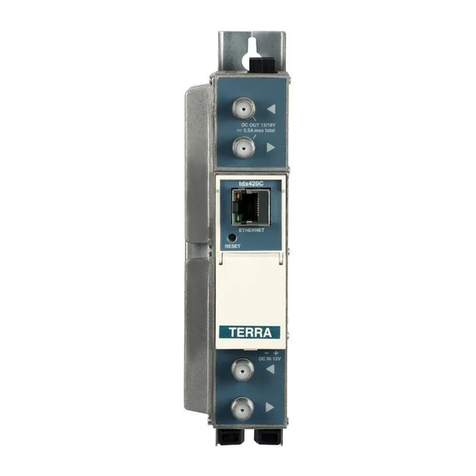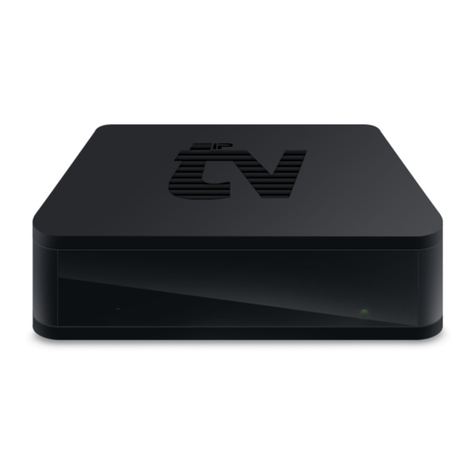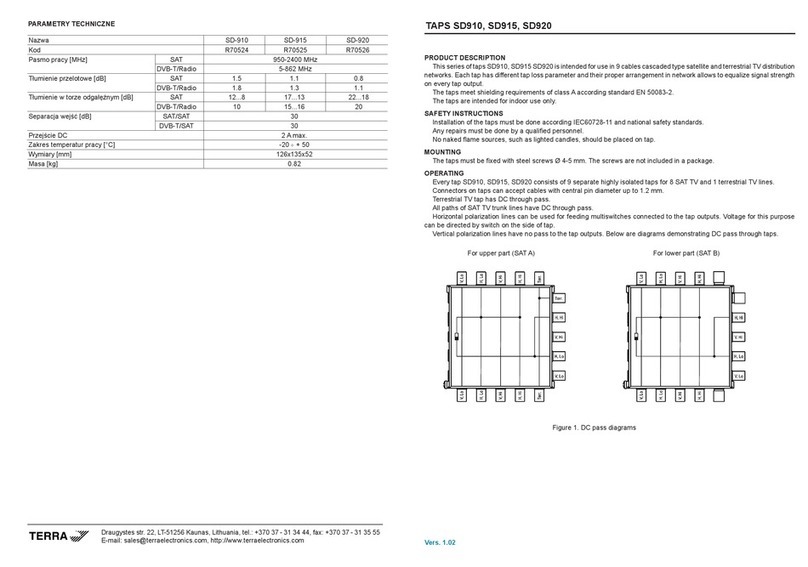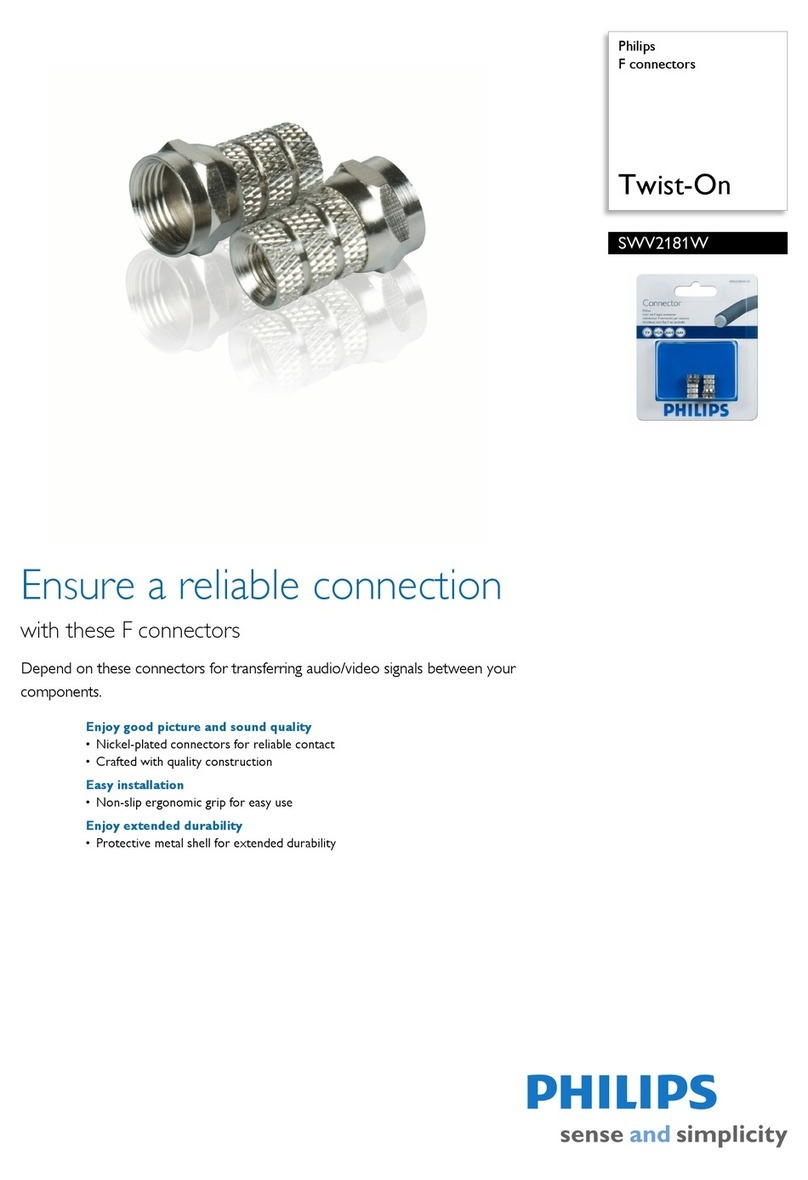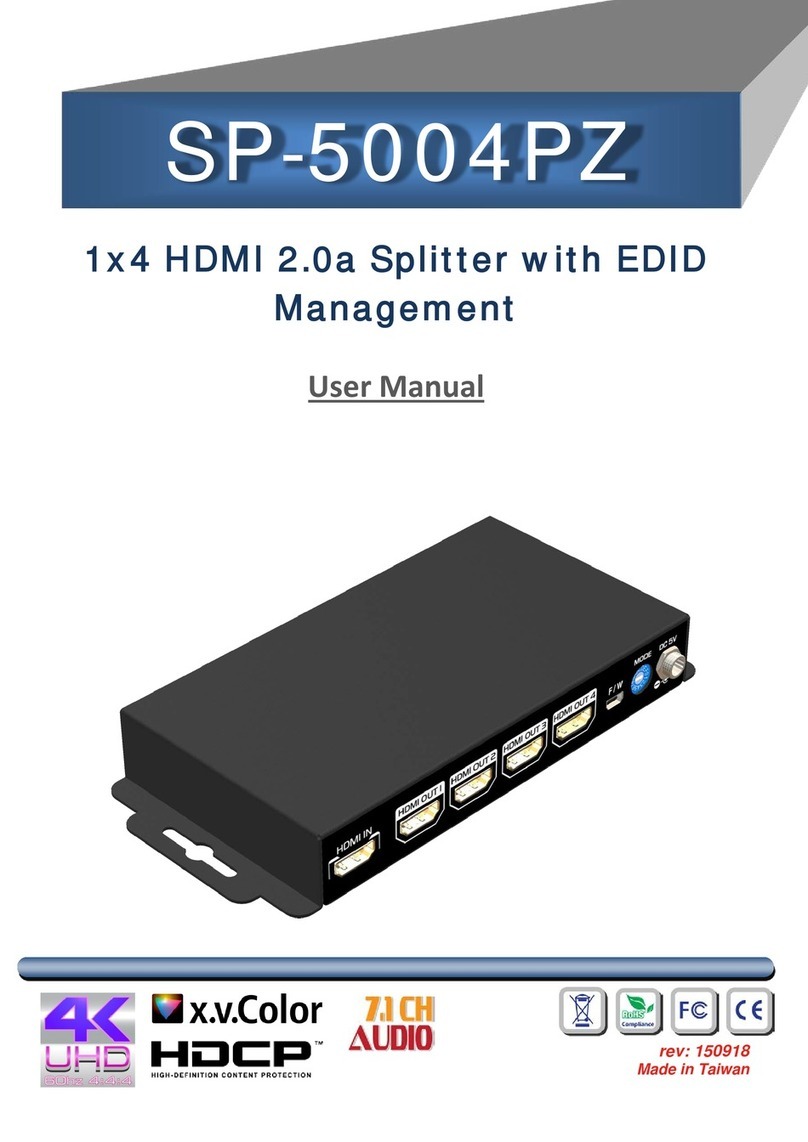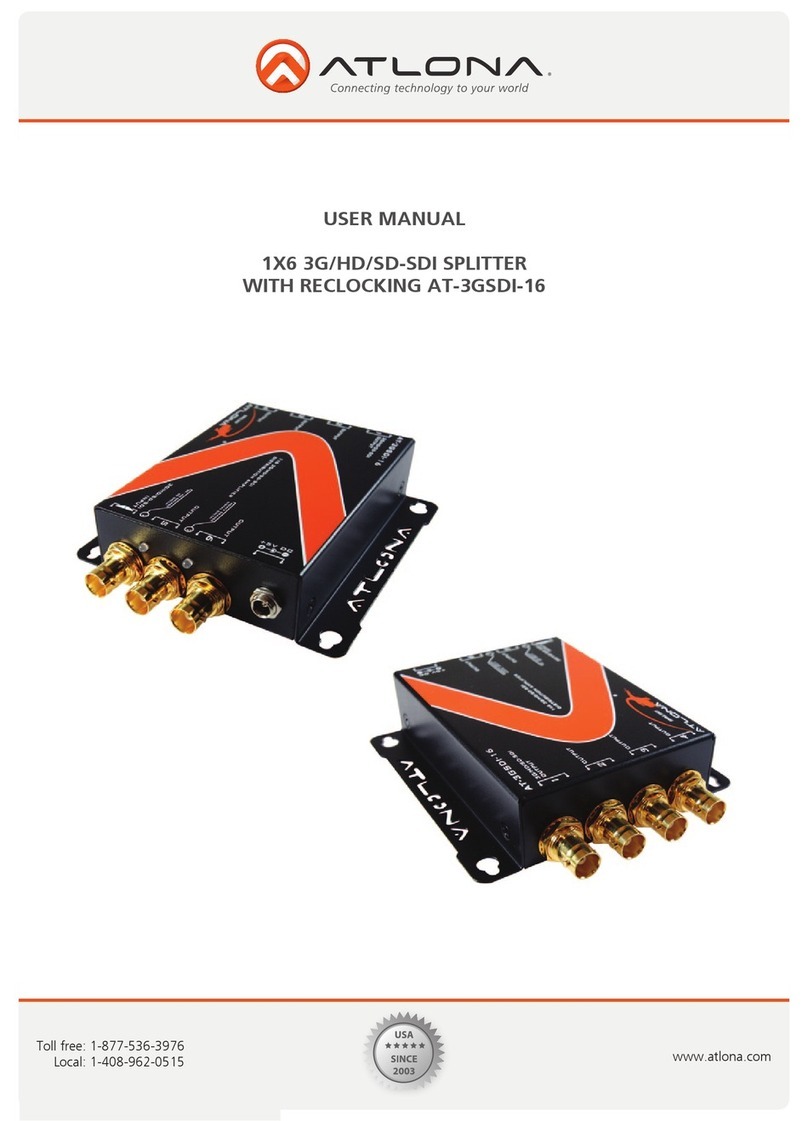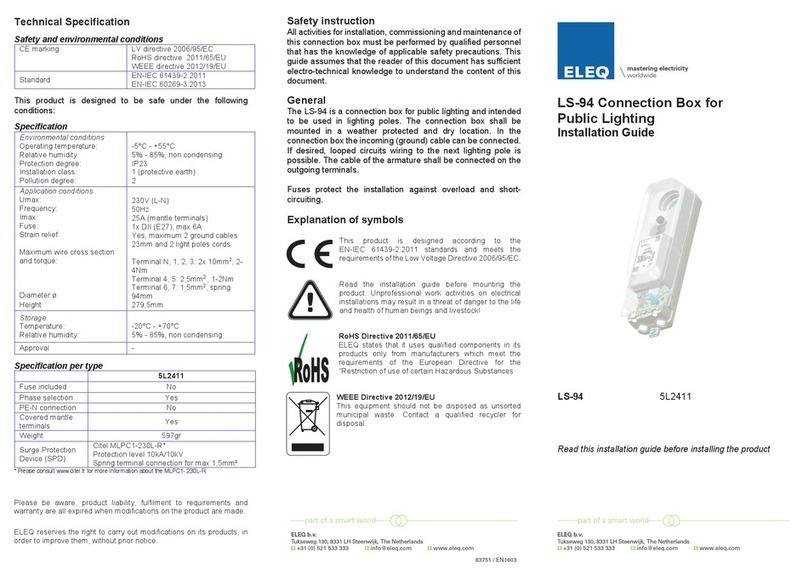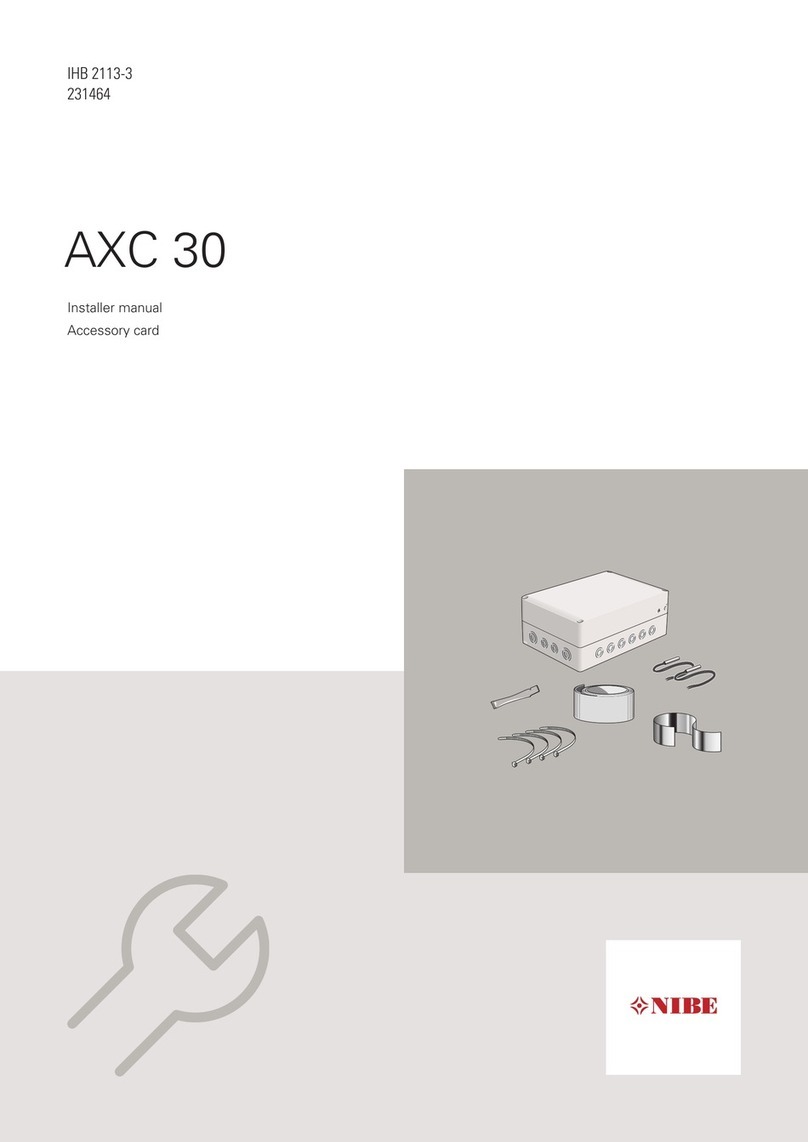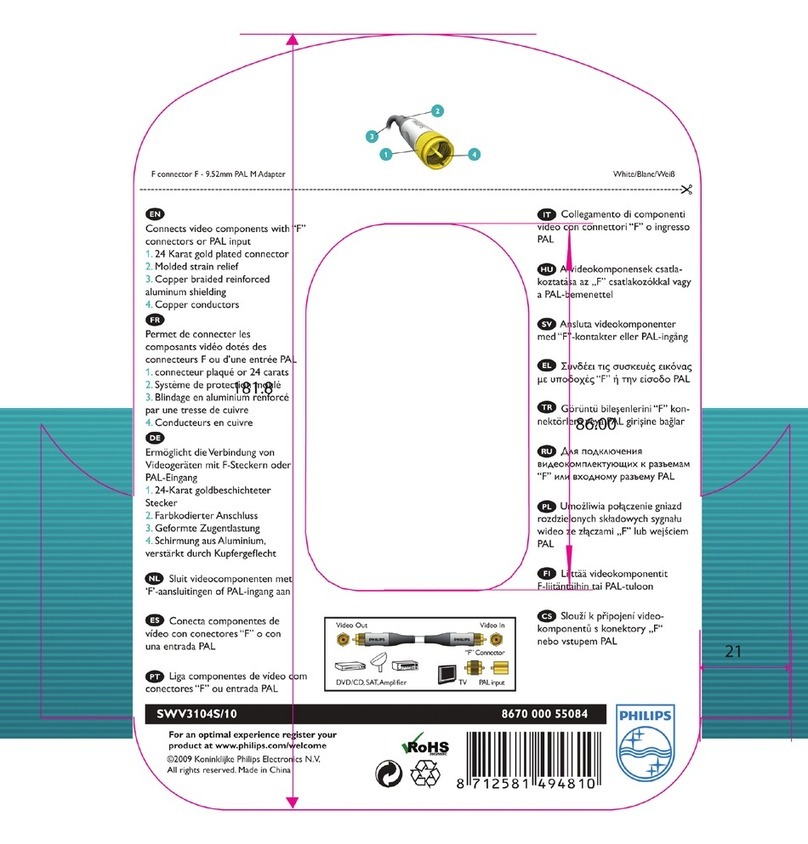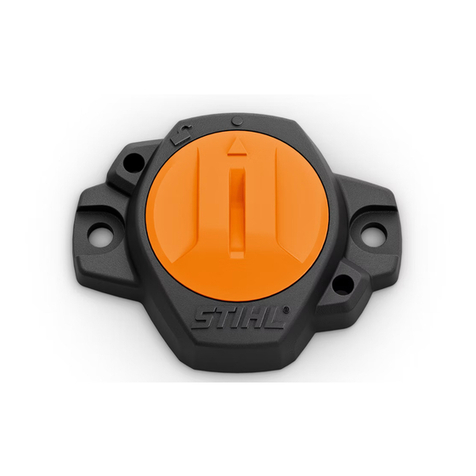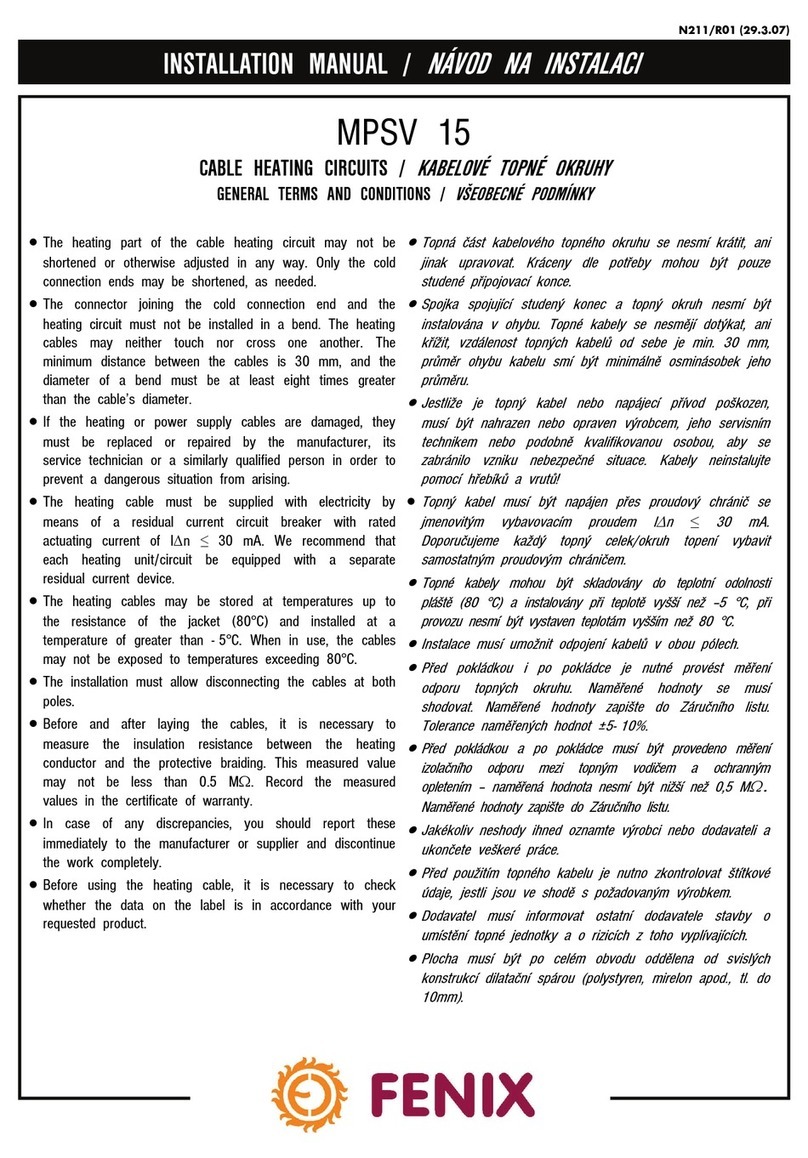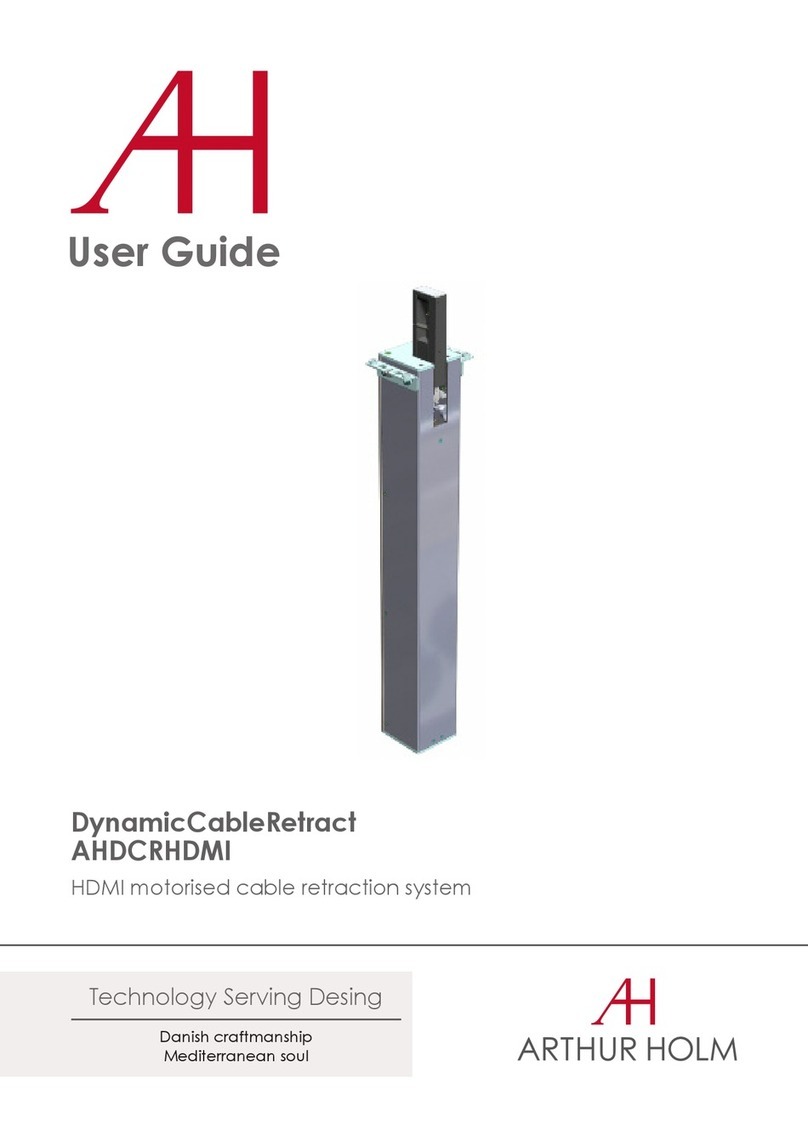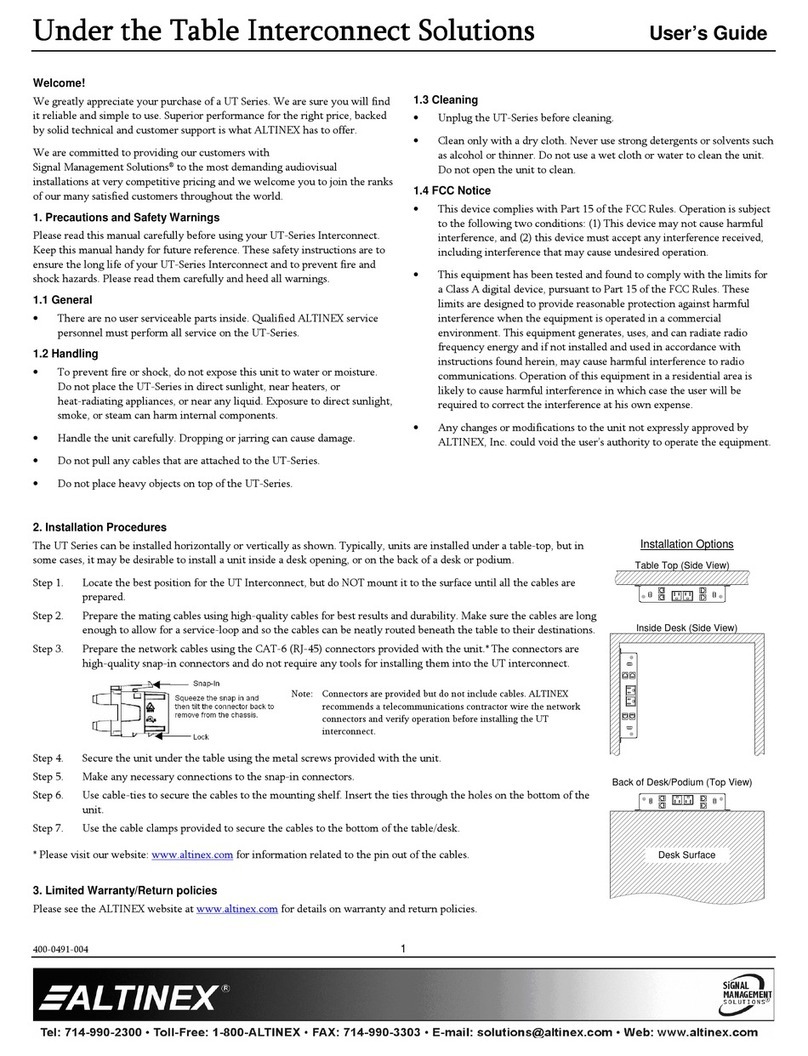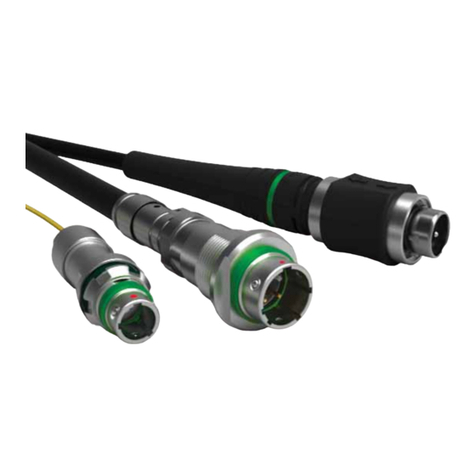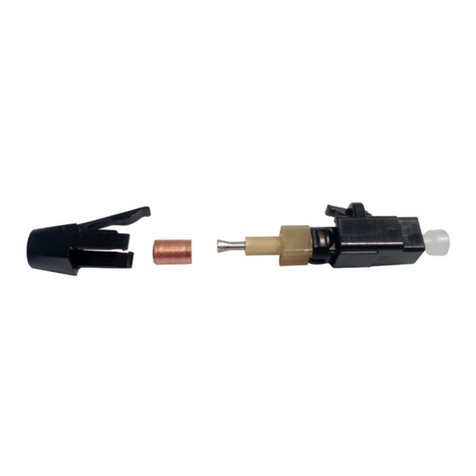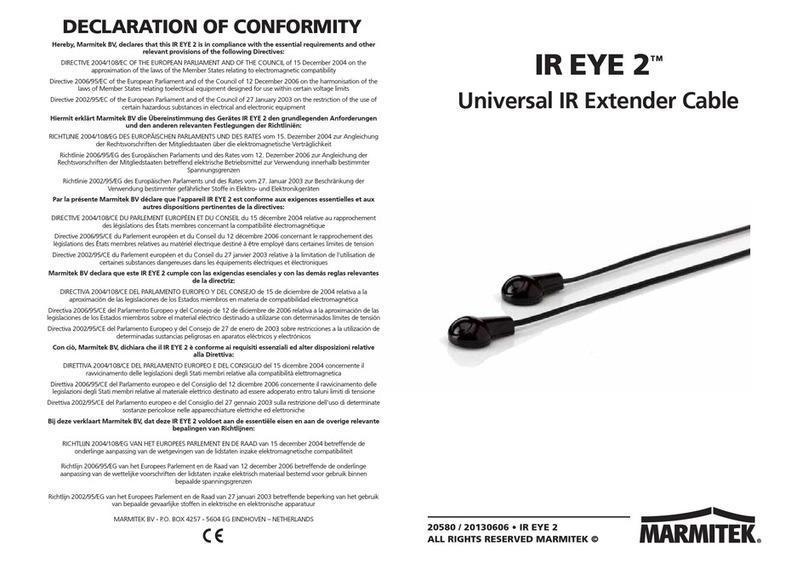Terra tdx4168 User manual

1
16 DVB-S/S2 to 8 DVB-T / ISDB-T / DVB-C / J.83B transmodulators
tdx4168, tdq4168
EN
Vers. 1.02
This product complies with the relevant clauses of the European Directive 2002/96/EC. The unit must be recycled
or discarded according to applicable local and national regulations.
Equipment intended for indoor usage only.
This product is in accordance to following norms of EU: EMC norm EN50083-2, safety norm EN IEC62368-1, RoHS norm EN50581.
This product is in accordance with Custom Union Technical Regulations: “Electromagnetic compatibility of technical
equipment“ CU TR 020/2011, “On safety of low-voltage equipment“ CU TR 004/2011.
This product is in accordance with safety standard AS/NZS 60065 and EMC standards of Australia.
1. Product description
The transmodulators are designed for digital transmodulation with Transport Stream Processing. Modules processor
enables services ltering, remultiplexing, modifying SI (Service Information), generating NIT (Network Information table),
LCN (Local Channel Number), restamping PCR (Program Clock Reference). All of the congurations can be changed using
the Web Interface.
tdx4168 – transmodulator with 16 DVB-S/S2 input channels and 8 DVB-T/ISDB-T output channels (outputs are grouped
into 2 groups that consists of four neighbouring channels).
tdq4168 – transmodulator with 16 DVB-S/S2 input channels and 8 DVB-C/J.83B output channels (outputs are grouped
into 2 groups that consists of four neighbouring channels).
Transmodulator can be used as stand alone device or as part of the headend station.
The product is intended for indoor usage only.
2. Safety instructions
Installation of the transmodulator must be done according IEC60728-11 and national safety standards.
Any repairs must be made by skilled personnel.
Do not expose this transmodulator to moisture or splashing water and make sure no objects lled with liquids, such as
vases, are placed near or on the unit.
Avoid placing the transmodulator next to heat sources such as central heating components or in areas of high humidity.
Keep the transmodulator away from naked ames.
If the transmodulator has been kept in cold conditions for a long time, bringing it into a warm environment may cause
condensation, so allow it to warm up for no less than 2 hours before plugging into the mains.
Ventilation should not be impeded by covering the transmodulator, such as newspapers, table-cloths, curtains etc.
Mount the transmodulator in a vertical position only. If installing in a 19” rack system additional forced air cooling fans
may be required (see table "Technical specications" - operating temperature range).
Always allow 10 cm of free space from the top, front and bottom of the unit to enable any heat to be dissipated.

2
3. External view
1 - ◄ - RF input of SAT IF signal, DC output for LNB.
2 - ►- RF output (input signal loop-through). F socket.
3 - ETHERNET - control Ethernet interface. RJ45 socket.
4 - ACTIVITY (yellow) indicator of the control Ethernet interface.
5 - LINK (green) indicator of the control Ethernet interface.
6- RESET - reset and default IP button.
Press this button shortly to restart the module. Press this button for
more than three seconds to set default IP address of the control
Ethernet interface.
7 - RF input (output signal loop-through). F socket.
8 - RF output. F socket.
9- Power distribution bus connector.
10 - +12 V DC powering input. Screw terminal.
Figure 1. External view of the transmodulator
DC OUT 13/18V
1 A max
DC IN 12V
-
-
+
+
tdx4168
RESET
ETHERNET
TERRA
1
2
4
5
3
6
7
8
tdx4168
DC IN 12V
-
-
+
+
9
10
DC OUT 13/18V
1 A max
DC OUT 13/18V
1 A max

3
4. Installation instructions
Read the safety instruction rst.
All settings can be changed using the web browser via control Ethernet interface.
Disconnect power supply unit from the mains before making any changes in the connections of the module. Fasten the
module on DIN RAIL or individual holder.
Connect all necessary RF, powering and control cables. Shielded Ethernet cable is recommended.
Connect the 75 W load to the unused RF output F sockets.
Connect power supply in to the mains.
Within 5-40 seconds of powering the module will run in normal operation mode.
Comments of the front panel indicators:
if the link with the control Ethernet interface is established - the LINK [6] indicator glows;
the ACTIVITY [5] indicator blinks, if communication via the control Ethernet interface is active.
5. MOUNTING
The module or mounting bracket must be xed with steel screws Ø 3.5-4 mm. The screws are not included in a package.
Mounting bracket on DIN rail should be connected to main potential equalization bus.
Mounting on a wall by screws Mounting on a bracket (supplied)
Perpendicular to the wall Parallel to the wall
Figure 2. Mounting of the transmodulator
Package contents
1. Transmodulator............................................................. 1 pcs.
2. Holder ........................................................................... 1 pcs.
3. Spacer .......................................................................... 1 pcs.
4. 75 W terminator ............................................................. 1 pcs.
5. Bridge F quick to F quick .............................................. 1 pcs.
6. User manual ................................................................ 1 pcs.
Requirements for external power supply unit
• Output voltage +12 V ± 0.5 V
• Ripple at single and/or double mains frequency < 10 mV p-p
• Ripple & noise < 100 mV p-p
• Short circuit protection
• Double insulated (marked )
• Meet EN 55022 class B conducted emisions requirements, measuring with grounded load

4
1. 2.
Mounting on DIN rail
Figure 5. Mounting or removing to/from
DIN rail of plastic spacers (supplied).
Figure 3. Mounting to DIN rail
Figure 4. Mounting from DIN rail
DC IN 12V
-
-
+
+
TERRA
RESET
ETHERNET
tdx4168
DC IN 12V
-
-
+
+
TERRA
RESET
ETHERNET
DC IN 12V
-
-
+
+
TERRA
RESET
ETHERNET
tdx4168 tdx4168

5
6. Operating
6.1 Initial conguration
All modules leave the factory with this control over Ethernet interface IP address: 192.168.1.10. In order to avoid conicts
with other IP addresses, it is necessary to perform an initial conguration in the local mode. Subsequently, it will be possible
to access the module via local area network (LAN), either to change the conguration or to check the operating status.
The modules leave the factory with the following control over Ethernet interface TCP/IP conguration:
IP address of the module: 192.168.1.10
Subnet mask: 255.255.255.0
Default Gateway: 192.168.1.1
To access each module, use a personal computer (PC) equipped with an Ethernet card and
RJ-45 cable (CAT-5E or CAT-6). The IP address of the PC/MAC must be congured within
the following range: 192.168.1.2 - 192.168.1.254 (do not use 192.168.1.10, since this is the
IP address of the module to be congured). To start the conguration of the module, open
your web browser and type in the following direction: http://192.168.1.10. The login prompt
will appear on the screen (see Figure 6).
Figure 6. Login window
Access to the module is protected by user name and password. The default user name and password is admin. Enter
the user name and password and click on "Login" button.
NOTE*: the default password - admin - can (and must) be changed as explained in the section 6.11.5 "User management".
During initial conguration you need to change the default control interface TCP/IP conguration as explained in the section
6.9 "IP settings".
NOTE**: If you are using Internet Explorer Web browser, supported versions are version 10 or higher.
Control interface IP address reset to default procedure: press the "RESET" [7] button for more than 3 seconds and release
it. After this operation the control interface IP address will be set to 192.168.1.10, user name and password set to admin.
6.2 General conguration
Initial Web interface screen
The rst screen that appears when the module accessed is the "Main" window, which gives general information on the
device.
Figure 7. General information screen
In the top of each conguration screen you will see a main menu tabs [1]. Using it, you can switch between the dierent
conguration menu. The tab highlighted in yellow shows which menu is active at a given moment. The "System menu" tab
contains several submenu items. Also common elements for all screens are module title [2] and login information strings
[3]. The module title can be changed after pressing the "Change" button in the "Device information" table. Pressing on the
"Logout" string you can logout from module control.
[1]
[2]
[3]

6
Device information table
This shows the following data of module:
“Device model”: model of the module.
“Serial number”: serial number of the module.
“Software version”: module software version number.
“System time”: current time, synchronized from the TDT table of the input stream or NTP server. Local time oset can be
selected in the "IP settings" tab, see section 6.9 "IP settings".
“Up time”: time passed from last power-up or restart of the module.
Output bitrates table
It displays the output bitrate status of each channel in real time, Horizontal bar shows the percentage of used available
bandwidth in the channel. The 1st number right to the bar shows actual bitrate in Mbps. Next number shows maximum allowed
bitrate in the channel and it depends on modulation parameters. Ensure that actual bitrate would not reach more than 95%
of available bandwidth. Otherwise bitrate overow may occur.
System status table
It represents the following parameters at real time: Processor load in percents, internal temperature in degrees of Celsius,
power voltage in Volts.
Other device in the network
If there are any modules in the network their status and diagnostic information will be displayed as it is in Figure 7 "General
information screen". If modules status is red press the down arrow and diagnostic errors will be displayed. Make sure, that
Ethernet router is congured properly to pass SSDP packets (239.255.255.250:1900 and 239.255.255.246:7900). Also make
sure that all modules are connected to the same Ethernet network
Diagnostic information table
It displays all module errors and comments how to eliminate them.
Figure 8. Diagnostic information table with errors
6.3 RF inputs
Figure 9. "Input 1" table (DVB-S/S2 input only) Figure 10. "Input 1" table "Source types = dSCR"
The Figure 9 "Input 1" table in modules with DVB-S/S2 input consists of the following parameters:
"LNB LO frequency" - the LNB local oscillator lower frequency in megahertz. Use 9750 MHz for the universal converter.
"LNB HI frequency" - the LNB local oscillator upper frequency in megahertz. Use 10600 MHz for the universal converter.
“LNB Power” - power supply of the converter – can be set to “0”, “13V”, “18V”, “13V/22kHz”, “18V/22kHz”.
"Polarization" - the polarization of converter. Can be "Horizontal" or "Vertical".
“Source type” - the LNB types, there are several: Universal, Quadro, DiSEqC, dSCR EN50607, SCR EN50494 - see Figures
9, 10.

7
“Universal LNB” - power supply voltage of the converter is chosen according
to the selected polarization – 18 V Horizontal, 13 V Vertical; the 22 kHz is
set depending on given "LNB HI frequency" "LNB LO frequency" and “Input
frequency” parameters.
For example:
LNB Hi=10,600, LNB Lo=9750, then F=(950+10,600+2150+9750)/2=11,725 MHz.
“DiSEqC” - then DISEQC commands are used to select the satellite. Possible
commands: “Satellite A”, “Satellite B”, “Satellite C”, “Satellite D”, Vertical or
Horizontal polarization.
"dSCR" – first select source type as shown in Figure 10, then select
“dSCR/SCR mode“ Master or Slave (Master for module which has direct
connection to Unicable multiswitch or LNB and Slave for modules connected by
loop through). If Slave was selected, additionally type the IP address of Master
module. All the modules in the dSCR/SCR group must be in the same Ethernet
network. Next select "SAT input" and "User band", type in frequencies, symbol
rate press “Update” button and observe "dSCR" status.
"SCR" - same as "dSCR", just the user band frequencies must be typed in
manually as shown in Figure 11.
Figure 11. "Input 1" table "Source types = SCR"
Figure 12. Status table
The Figure 13 "Demodulator settings table" in modules with DVB-S/S2 input consists of the following parameters:
„SAT input“ - A parameter that can switch demodulator o or connect to any available RF input.
“User band” - parameter used in dSCR/SCR Switches.
„Input frequency“ - parameter is a frequency of transponder in MHz.
„Symbol rate“ - parameter is a symbol rate of transponder in kSym/s.
Figure 13. Demodulator settings table

8
Figure 14. Demodulator status table
The following information is displayed in the table “Demodulator status”:
“RF level” - RF signal level at the module input. Level indication - approximate.
The values of the following parameters are displayed only if the module has synchronized with the input signal.
“Modulation standard” - detected standard of the input signal. Possible values of the standard: DVB-S, DVB-S2.
“Frequency” - intermediate frequency (for DVB-S/S2) at the module input.
“Modulation” - modulation scheme of the input signal. Possible values of the modulation scheme: QPSK, 8PSK (for DVB-S/S2).
“FEC” - forward error correction.
“SNR” - RF signal/noise ratio at the input of module.
“VBER” - bit error rate after Viterbi corrector. To get the signal without any errors at the output of the tuner, VBER shall not
exceed 2Е-4.
“PER” - ratio of the MPEG2 transport error packets to the whole number of packets. If the number of error packet is equal
to zero, the opposite value to whole number of packets is displayed. Packet counters are reset during RF input parameters
update.
“Input bitrate” - bitrate of the input signal.
6.4. Transport Streams
One channel at a time can be congured in this page. Select proper channel from the list at „Choose input channel“
combobox (see Figure 15 "Transport streams page").
Figure 15. Transport streams page

9
A list of services in the selected channel will appear. „List of services“ table shows a list of available services. Icon before
the service name indicates service type. Bitrate of each service is measured in real time. Services that currently are not
running will be displayed as grayed. They can be selected and will be outputted normally when the services starts to running.
„LCN“ eld is a Logical Channel Number. Every service can have a „channel number“ and TV will sort channels according to
it. Just ensure, that all services in all channels have dierent numbers. Value 0 means, that LCN for that service is not used
at all and TV will sort these channels according to it’s own rules. If channel numbers are added, but TV does not recognize
it, check the following:
- If TV supports LCN?
- If Network ID and Original Network ID values are valid for the country, which is selected on TV?
„Enable“ dropbox enables the service to the selected output.
“Descramble” checkbox enables or disables descrambling.
Press onto „+“ sign and service information will be extended (see Figure 16 "Service details").
Figure 16. Service details
“Service title“ and “Service provider“ can be edited (multilanguage character support). „Scrambled ag“ will be inserted
into SDT (Service Description Table). Unchecking this checkbox will not descramble the content. It only carries information
about the scrambling status of the service.
BISS scrambled services have a BISS key input eld "BISS Code". Enter the BISS code (12 or 16 characters) in hex
format.
"Service type": this is an 8-bit eld specifying the type of the service. The assignment of service type value for a Service
is described in EN 300 468. It shall be coded according to Figure 17.
"Parental control": this selection enables ability to restrict certain content viewable by the user. For example, parental control
eld is set to "Less than 6 years", than all content with maturity rating above 6 years old will be ltered out.

10
Service type Description
0x00 reserved for future use
0x01 digital television service (see note 1)
0x02 digital radio sound service (see note 2)
0x03 Teletext service
0x04 NVOD reference service (see note 1)
0x05 NVOD time-shifted service (see note 1)
0x06 mosaic service
0x07 FM radio service
0x08 DVB SRM service [49]
0x09 reserved for future use
0x0A advanced codec digital radio sound service
0x0B H.264/AVC mosaic service
0x0C data broadcast service
0x0D reserved for Common Interface Usage (CENELEC EN 50221 [37])
0x0E RCS Map (see ETSI EN 301 790 [7])
0x0F RCS FLS (see ETSI EN 301 790 [7])
0x10 DVB MHP service
0x11 MPEG-2 HD digital television service
0x12 to 0x15 reserved for future use
0x16 H.264/AVC SD digital television service
0x17 H.264/AVC SD NVOD time-shifted service
0x18 H.264/AVC SD NVOD reference service
0x19 H.264/AVC HD digital television service
0x1A H.264/AVC HD NVOD time-shifted service
0x1B H.264/AVC HD NVOD reference service
0x1C H.264/AVC frame compatible plano-stereoscopic HD digital television service (see note 3)
0x1D H.264/AVC frame compatible plano-stereoscopic HD NVOD time-shifted service (see note 3)
0x1E H.264/AVC frame compatible plano-stereoscopic HD NVOD reference service (see note 3)
0x1F HEVC digital television service (see note 4)
0x20 to 0x7F reserved for future use
0x80 to 0xFE user dened
0xFF reserved for future use
NOTE 1: MPEG-2 SD material should use this type.
NOTE 2: MPEG-1 Layer 2 audio material should use this type.
NOTE 3: For information on the use of these values, see clause I.2.3 and ETSI TS 101 547-2 [54]
(3D Guidelines of Frame Compatible 3D-TV).
NOTE 4: For information on the use of these values, see clause I.2.5 and ETSI TS 101 547-4 [62].
Figure 17. Service type coding

11
Individual streams can be disabled as well. Also PID number can be remapped manually by selecting checkbox “Other
PID” (Keep in mind than PID must be unique) otherwise PID remapping is done automatically.
Press onto „Update“ button to save changes and execute.
NOTE: If transparent mode is selected, all services of transponder will be passed to the output, including original PAT, SDT,
PMT, EIT, CAT, NIT tables, all changes that were made to these tables will be disregarded. No more than 95% of output
bandwidth usage is recommended, otherwise overow might occur.
6.5. NIT
Several tables related to NIT generation exist in this section. Figure 18 "Global TS parameters" describes following TS
parameters:
Figure 18. Global TS parameters
“Network ID”: is unique number within the geographical region dened by the “country code”. For a cable network usually
this is a single country code plus 0x2000 (8192). If there are more connected modulators in the network, they must have the
same Network ID.
Proper value depending on your country and operator can be found here:
http://www.dvbservices.com/identiers/network_id?page=1
“Private data specier (hex)”: can be inserted in the NIT table for proper LCN description. This value is described in TS
101162 specication. NorDig standard requires 00 00 00 29 value, UK should use 00 00 23 3A value.
Other options can be found here:
http://www.dvbservices.com/identiers/private_data_spec_id?page=1
The parameter will not be inserted into NIT if value is set to zero.
„Network name“ is the name of the network.
The 2nd table in the page describes Transport stream ID and Original network ID of each channel (see Figure 18). Each
stream in a network must have unique ID, called „Transport stream ID“. An Original_Network_ID is dened as the “unique
identier of a network”. It can be linked to Network ID or used value from this location:
http://www.dvbservices.com/identiers/original_network_id?page=1
Figure 19. Transport stream and original network IDs
Figure 20. Description of other streams in the network
Every channel in the network must be described in NIT. Otherwise TV automatic channel tuning function will not nd all
channels. All modules in the network will be monitored via standard SSDP protocol. NIT tables will be regenerated if any
change is detected in other modulators with the same Network ID. Make sure, that Ethernet router is congured properly to
pass SSDP packets (239.255.255.250:1900 and 239.255.255.246:7900). Also make sure that all modules are connected to
the same Ethernet network.
NOTE: If in the RF network exists transponders that is generated by old TERRA transmodulators/modulators, the
frequencies and modulation parameters must be lled manually (Figure 20).

12
6.6. TS info
This tab Lists all outgoing servises. You can easily lter out needed output channels by selecting needed output in table
"TS Info". This lets you quickly view and setup LCN for every channel also check your Output bitrate and ensure that it is
not overowing.
Figure 21. "TS Info" table

13
6.7. RF outputs
Transmodulators tdx4168, tdq4168 have two independent groups of four adjacent channels.
Figure 22. DVB-T output parameters (tdx4168)
"Output frequency“ parameter can be entered manually or selected as a channel from combobox. Channels that can be
selected from the list depend on which region is selected. If you need any other frequency – select “Manual” and type the
needed frequency. Frequency step is 0.1 MHz. „Enable“ checkbox will enable channel to the output. Global attenuator can
be entered up to 15 dB. Also there is individual precise attenuator up to 2.5 dB in step of 0.5 dB.
Press „Update“ to change settings. In case, if any modulation parameter was changed, both channels will be restarted
with new settings. Exception is „Attenuator“, changes in this parameter will not restart the modulator.
Figure 23. DVB-C output parameters (tdq4168)
Figure 21 shows tdq4168 DVB-C output settings. The step of RF channels can be selected to one of these values:
7.0, 7.5, 8.0, 8.3, 8.5 MHz. Actual bandwidth of each channel depends on the symbol rate, and can be calculated as SR x 1.15
(1.15 here is roll o factor of 15%). Symbol rates of all channels must be the same, from the range of 3500..7200 kSym/s.
Output channel enumeration depends on the region selected from the main page. However, it's allowed to enter any
frequency you want in a range of 100..858 MHz in all devices.
Only the rst output frequency/channel of the group can be entered by the user. Other frequencies will be calculated
automatically according to the selected step/bandwidth.

14
6.8. SNMP settings
Figure 24 "SNMP settings" table is located in “IP parameters” tab.
The description of the SNMP conguration parameters:
"Read Community" - community name acts as a password that is shared
by multiple SNMP agents and one or more SNMP managers. "Read
Community" password is used for read-only access to the modules
parameters.
"Write Community" - is the password used for read-write access to the
modules parameters.
"Enable TRAP" - SNMP traps are alerts generated by agents on a managed
device. Check this box to enable TRAP generation. The module generates
traps when the diagnostic message occurs.
"TRAP Community" - is the password used for accessing of TRAPS.
"Host IP #1","Host IP #2""Host IP #3" - IP addresses of hosts with SNMP
managers, where TRAPS will be send.
Figure 24. "SNMP settings" table
6.9 IP settings
All device IP settings can be congured here – IP address, subnet mask,
gateway, DNS (Domain Name System), see Figure 25 "IP settings table".
IP parameters will be updated immediately after pressing „Update“ button
and redirect to new location.
NOTE: Press the RESET and default IP button for more than three seconds
to set default IP address of the control Ethernet interface (see Figure 1
"External view of the module").
Figure 25. IP settings table
6.10 E-mail-settings
The device can send e-mail reports if errors were detected. SMTP
protocol is used for that. Figure 26 “E-mail-settings table” shows
parameters related to this feature. “Enable e-mail error report”
checkbox enables error monitoring. All errors within “timeout”
period will be gathered, and send to the e-mail address, provided
in “Receiver e-mail address” input box. Comma separated e-mail
addresses can be used to send report to multiple addresses. The
timer will be started as soon, as the rst error is detected, and
stopped when e-mail is sent. The timer will be restarted again if
a new error will appear.
“Sender e-mail address” can be used as authentication in the
SMTP server side.
SSL (SMTPS) protocol is not supported.
Figure 26. E-mail-settings table

15
6.11 System menu
This menu tab contains following submenu items: “Event logs”, “Export parameters”, “Import parameters”, “Firmware
upgrade”, “User management”, “Restore defaults“, “Restart the device“, “Auto Restart“, “Time, Date”, “Language”. Mouse
over to show the list of this submenu.
6.11.1 Event logs
Various important events, errors, warnings will be logged into the system, see Figure 27 "Event logs". Each record has
an event type, which can be used to lter particular messages. Just select checkboxes in the „Logs ltering“ table and press
„Apply“. Other messages will be hidden.
„Erase logs“ button will erase all logs from the system.
“Export logs” button forms the le (log.html) which will be downloaded to PC.
Each record has a log time when the event appeared. Refer to 6.11.9 "Date, Time" settings for instructions how to
congure time settings.
Figure 27. Event logs
6.11.2 Export parameters
All settings of transmodulator can be exported for backup or copying to another device. Press “Export parameters” and
“parameters.xml” le will be downloaded to PC. This le can be imported only to the same type of device.
6.11.3 Import parameters
Exported parameters can be imported back to the device. Press onto “Click to select le” button (see Figure 28 "Import
parameters") to select exported le.
Figure 28. Import parameters
Press “Upload” button to send the le to the device.It will take several seconds to update all parameters after le upload.
After that, device will function with new conguration. No restart is required.
6.11.4 Firmware upgrade
Device rmware can be upgraded via web browser. Press the “Click to select le” button and select rmware binary le. If
valid le was selected, a version number of new rmware will be displayed. Otherwise an error message will appear. Press
the “Upload” button to upload new rmware to the device. Upload progress bar will appear and may take several seconds
to upload, depending on the size of a le and a network connection speed. A message will be displayed asking to restart
the device when the le was sent to the device. New rmware will be programmed into the device only after restart. It may
take additional minute or more to ash new program. Device will start up with a new rmware and continue to operate with
previous parameters. Additional new rmware features (if any) may need to setup additionally to take eect.
Avoid power supply interruption when a programming process is going on.
Device has possibility to load software revision history and check availability for new software release. Click the “Check
online” link. If computer (not device!) has internet access, it will show a list of all software releases with links to binary les.
Binary le can be downloaded and saved to computer (see Figure 29 "Firmware upgrade"). After that, use the rmware
upgrade method as described above.

Figure 29. Firmware upgrade
6.11.5 User management
User may change a password here. Length of the password is up to 16 symbols. Type current password and double enter
new password to change it.
If logged in user has admin role, new users can be added (see Figure 30 "User management").
Figure 30. User management
Enter it’s username, password, select a role and press „Add“ button.
Only administrator (user with a role „admin“) may manage other users.
NOTE: By giving your personal password or user access account for another person, you take full responsibility for all
module settings modications made by that person or anyone else they may give the password to.
6.11.6. Restore defaults
All parameters will be restored back to factory defaults after conrmation. The exception – IP address and users – these
parameters will be unchanged. To restore IP address and system password to system defaults, see „RESET“ button at
section 3, pos.7.
Several seconds can take to restore all parameters, so be patient.
6.11.7. Restart the device
Device will be restarted after conrmation to do it. This is an alternative to pressing a „RESET“ button when the device is
operating.
16

6.11.8. Auto Restart
Enable "Auto restart" to schedule periodical restart. Fill in "Scheduled restart time" to restart device on the particular time.
The restart will occure every day on specieed time.
6.11.9. Date, Time
System time can be congured manually or taken from NTP server (only if module can access NTP server). Also there is
an option to select the time source from TS as shown in the Figure 31.
Figure 31. "Date, Time" settings table
6.11.10. Language
Device control panel supports several preinstalled languages. A change of language requires system restart. Note, that
all previously logged records will remain in previous language.
Additional languages can be installed under request. Contact our distributors for such possibility.
7. Regions
Device supports several preinstalled regions. Region can be changed without restarting the device, just select needed
region by pressing “Change” button in “Device information” table. The RF channel list depends on which region is selected.
Additional regions can be installed under request. Contact our distributors for such possibility.
17

Draugystes str. 22, LT-51256 Kaunas, Lithuania, tel.: +370 37
-
31 34 44, fax: +370 37
-
31 35 55
Type tdx4168 tdq4168
Sections input/output 16/8
RF input frequency range 950-2150 MHz
LNB powering/control 0/13/18 V & 22 kHz, 1 A total, DiSEqC 1.0, EN50607, EN50494
level / impedance 55-95 dBµV / 75 W
modulation QPSK, 8PSK (DVB-S/S2)
symbol rate 2 ÷ 45 Ms/s
return loss ≥ 10 dB
RF input count 2
loop through frequency range 950-2150 MHz
loop through loss ≤ 1.5 dB
RF output standard DVB-T / ISDB-T DVB-C / J.83B
modulation QPSK, QAM16, QAM64 QAM16, QAM32, QAM64, QAM128, QAM256
frequency range 170-230 MHz / 470-862 MHz 96-862 MHz
channel allocation, adjacent 4 +4
level / impedance 90 ± 2 dBµV / 75 W
TS bit rate < 31 Mbit/s < 53 Mbit/s
MER ≥ 35 dB ≥ 40 dB
channel bandwidth 7 MHz / 8 MHz 4...8.3 MHz
guard interval 1/4, 1/8, 1/16, 1/32 -
code rate 1/2, 2/3, 3/4, 5/6, 7/8 -
symbol rate - 3.5 ÷ 7.2 Ms/s
return loss ≥ 10 dB
roll off - 15%
transmission mode 2K -
total output level adjustment 0 ÷ -15.0 dB by 1 dB step
loop through frequency range 45-862 MHz
loop through loss ≤ 2.5 dB
Management port standard IEE802.3 10/100 Base T
Supply voltage 12 V ±1 V
Current consumption without external DC feeding 1.2 A
Current consumption with max. external DC feeding 3.3 A
Operating temperature range 0o ÷ +45o C
Dimensions/Weight (packed) 63x198x112 mm/1.12 kg
8. Technical specications
pr.
pr.
pr.
pr.
pr.
pr.
pr.
pr.
pr.
pr.
pr.
pr. software control
This manual suits for next models
1
Table of contents
Other Terra Cables And Connectors manuals
